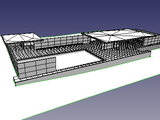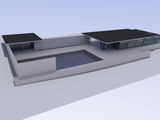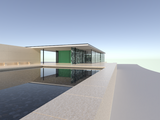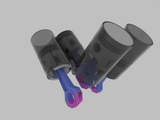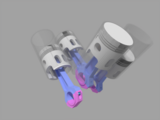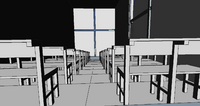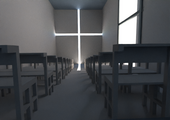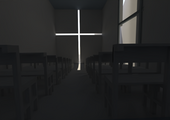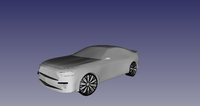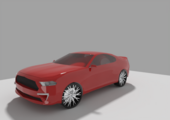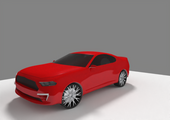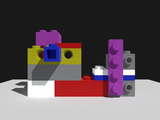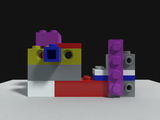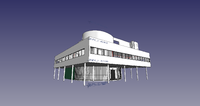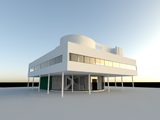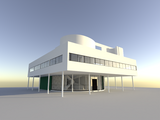Render Workbench: Difference between revisions
No edit summary |
(Marked this version for translation) |
||
| Line 2: | Line 2: | ||
<translate> |
<translate> |
||
<!--T:1--> |
|||
[[File:Render_workbench_icon.svg|thumb|128px|Render Workbench icon]] |
[[File:Render_workbench_icon.svg|thumb|128px|Render Workbench icon]] |
||
| Line 8: | Line 9: | ||
<translate> |
<translate> |
||
== Introduction == |
== Introduction == <!--T:2--> |
||
<!--T:3--> |
|||
The Render Workbench let's you produce high-quality images from FreeCAD models, using open-source external rendering engines. |
The Render Workbench let's you produce high-quality images from FreeCAD models, using open-source external rendering engines. |
||
<!--T:4--> |
|||
<gallery mode=nolines widths=200px perrow=3> |
<gallery mode=nolines widths=200px perrow=3> |
||
Image:Pabellon_de_Barcelona.png|Barcelona pavilion<br>Screenshot |
Image:Pabellon_de_Barcelona.png|Barcelona pavilion<br>Screenshot |
||
| Line 33: | Line 36: | ||
</gallery> |
</gallery> |
||
<!--T:5--> |
|||
A pure Python workbench, Render is seamlessly integrated in FreeCAD: the whole rendering scene - objects, lighting, materials, camera, etc. - can be described with FreeCAD objects, to be exported to external renderers. |
A pure Python workbench, Render is seamlessly integrated in FreeCAD: the whole rendering scene - objects, lighting, materials, camera, etc. - can be described with FreeCAD objects, to be exported to external renderers. |
||
<!--T:6--> |
|||
Compared with other approaches based on third-part computer graphics applications, Render aims to: |
Compared with other approaches based on third-part computer graphics applications, Render aims to: |
||
* Avoid the user to learn another 3D/computer graphics software: everything you need to know is in FreeCAD. |
* Avoid the user to learn another 3D/computer graphics software: everything you need to know is in FreeCAD. |
||
| Line 40: | Line 45: | ||
* Make scene configuration persistent and especially prevent rework in an external tool each time the model has been modified. |
* Make scene configuration persistent and especially prevent rework in an external tool each time the model has been modified. |
||
== Supported renderers == |
== Supported renderers == <!--T:7--> |
||
<!--T:8--> |
|||
At the moment six rendering engines are supported: |
At the moment six rendering engines are supported: |
||
* LuxCoreRender |
* LuxCoreRender |
||
| Line 50: | Line 56: | ||
* Pbrt-v4 (experimental) |
* Pbrt-v4 (experimental) |
||
== Usage == |
== Usage == <!--T:9--> |
||
<!--T:10--> |
|||
In quick-start mode, after workbench installation has correctly been done, rendering a FreeCAD model is just a 4-step process: |
In quick-start mode, after workbench installation has correctly been done, rendering a FreeCAD model is just a 4-step process: |
||
<!--T:11--> |
|||
# '''Create a rendering project:''' Press the button in the toolbar corresponding to your renderer and select a template suitable for your renderer (you may start with a 'studio' flavour, like {{FileName|appleseed_studio_light.appleseed}}, {{FileName|cycles_studio_light.xml}}, {{FileName|luxcore_studio_light.cfg}}, {{FileName|povray_studio_light.pov}} etc.). |
# '''Create a rendering project:''' Press the button in the toolbar corresponding to your renderer and select a template suitable for your renderer (you may start with a 'studio' flavour, like {{FileName|appleseed_studio_light.appleseed}}, {{FileName|cycles_studio_light.xml}}, {{FileName|luxcore_studio_light.cfg}}, {{FileName|povray_studio_light.pov}} etc.). |
||
# '''Add views of your objects to your rendering project:''' Select both the objects and the project, and press the {{Button|Add view}} button. |
# '''Add views of your objects to your rendering project:''' Select both the objects and the project, and press the {{Button|Add view}} button. |
||
| Line 59: | Line 67: | ||
# '''Render:''' Select your project and press the {{Button|Render}} button in toolbar (also available from project's context menu). |
# '''Render:''' Select your project and press the {{Button|Render}} button in toolbar (also available from project's context menu). |
||
<!--T:12--> |
|||
'''And you should get a first rendering of your model.''' |
'''And you should get a first rendering of your model.''' |
||
<!--T:13--> |
|||
More instructions can be found in the [https://github.com/FreeCAD/FreeCAD-render GitHub repository] or the online help. |
More instructions can be found in the [https://github.com/FreeCAD/FreeCAD-render GitHub repository] or the online help. |
||
== Features == |
== Features == <!--T:14--> |
||
<!--T:15--> |
|||
Features include, but are not limited to: |
Features include, but are not limited to: |
||
* Lighting: point lights, area lights, sun-sky and preset lighting templates. |
* Lighting: point lights, area lights, sun-sky and preset lighting templates. |
||
| Line 74: | Line 85: | ||
* Meshing control: angular and linear deflections, auto-smoothing. |
* Meshing control: angular and linear deflections, auto-smoothing. |
||
== Links == |
== Links == <!--T:16--> |
||
<!--T:17--> |
|||
More info? Just follow the link: https://github.com/FreeCAD/FreeCAD-render |
More info? Just follow the link: https://github.com/FreeCAD/FreeCAD-render |
||
Latest revision as of 18:07, 13 September 2023

Introduction
The Render Workbench let's you produce high-quality images from FreeCAD models, using open-source external rendering engines.
-
Barcelona pavilion
Screenshot -
Barcelona pavilion
Povray rendering -
Barcelona pavilion
Cycles rendering -
Asm V4
Screenshot -
Asm V4
LuxCore rendering -
Asm V4
Ospray rendering -
Church of the light
Screenshot -
Church of the light
LuxCore rendering -
Church of the light
Cycles rendering -
Car
Screenshot -
Car
Ospray rendering -
Car
LuxCore rendering -
Brick assembly
Screenshot -
Brick assembly
Appleseed rendering -
Brick assembly
Luxcore rendering -
Villa Savoye
Screenshot -
Villa Savoye
Appleseed rendering -
Villa Savoye
Cycles rendering
A pure Python workbench, Render is seamlessly integrated in FreeCAD: the whole rendering scene - objects, lighting, materials, camera, etc. - can be described with FreeCAD objects, to be exported to external renderers.
Compared with other approaches based on third-part computer graphics applications, Render aims to:
- Avoid the user to learn another 3D/computer graphics software: everything you need to know is in FreeCAD.
- Simplify rendering workflow and relieve user from any intermediate file manipulation - like import, export, scene retouching etc.
- Make scene configuration persistent and especially prevent rework in an external tool each time the model has been modified.
Supported renderers
At the moment six rendering engines are supported:
- LuxCoreRender
- Appleseed
- Cycles (standalone version)
- Pov-Ray
- Intel Ospray Studio
- Pbrt-v4 (experimental)
Usage
In quick-start mode, after workbench installation has correctly been done, rendering a FreeCAD model is just a 4-step process:
- Create a rendering project: Press the button in the toolbar corresponding to your renderer and select a template suitable for your renderer (you may start with a 'studio' flavour, like appleseed_studio_light.appleseed, cycles_studio_light.xml, luxcore_studio_light.cfg, povray_studio_light.pov etc.).
- Add views of your objects to your rendering project: Select both the objects and the project, and press the Add view button.
- Set your point of view: Navigate in the 3D View to the desired position and switch to perspective mode.
- Render: Select your project and press the Render button in toolbar (also available from project's context menu).
And you should get a first rendering of your model.
More instructions can be found in the GitHub repository or the online help.
Features
Features include, but are not limited to:
- Lighting: point lights, area lights, sun-sky and preset lighting templates.
- Cameras.
- Material management (using usual shaders: matte, glossy, glass, principled etc.) including textures.
- Batch mode / UI mode.
- Denoiser.
- Halt condition (sample per pixel).
- Meshing control: angular and linear deflections, auto-smoothing.
Links
More info? Just follow the link: https://github.com/FreeCAD/FreeCAD-render
- Getting started
- Installation: Download, Windows, Linux, Mac, Additional components, Docker, AppImage, Ubuntu Snap
- Basics: About FreeCAD, Interface, Mouse navigation, Selection methods, Object name, Preferences, Workbenches, Document structure, Properties, Help FreeCAD, Donate
- Help: Tutorials, Video tutorials
- Workbenches: Std Base, Arch, Assembly, CAM, Draft, FEM, Inspection, Mesh, OpenSCAD, Part, PartDesign, Points, Reverse Engineering, Robot, Sketcher, Spreadsheet, Surface, TechDraw, Test Framework
- Hubs: User hub, Power users hub, Developer hub
